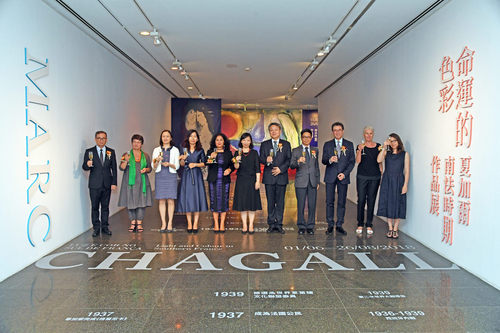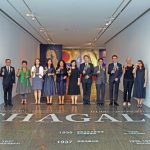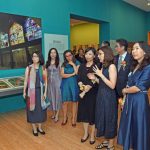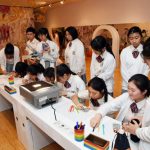 Exhibition “Marc Chagall, Light and Colour in Southern France” by Macao Museum of Art was inaugurated
Exhibition “Marc Chagall, Light and Colour in Southern France” by Macao Museum of Art was inaugurated
Organized by the Macao Museum of Art (MAM), under the auspices of the Cultural Affairs Bureau, and co-organized by the Macao Government Tourism Office and the Macao Foundation, the exhibition “Marc Chagall, Light and Colour in Southern France”, was inaugurated on Thursday, 31 May, at 6:30pm, on the 1st floor of the MAM. The exhibition, one of the highlights of the 29th Macao Arts Festival and of the 2018 Le French May, features over 100 works by Marc Chagall created between the 1950s and the 1970s. It includes paintings, gouaches, lithographs, costumes and tapestries, showing the pre-eminence of light and colour in his creations and transporting the public to a distant realm of illusion.
The opening ceremony was held in a lively atmosphere and was officiated by the President of the Cultural Affairs Bureau of the Macao S.A.R. Government, Mok Ian Ian; the Acting Consul General of France in Hong Kong and Macao, Paule Ignatio; the Assistant of the Deputy Director of the Department of Publicity and Culture of the Liaison Office of the Central People's Government in the Macao S.A.R., Shao Bin;the Deputy Director of the Department of Public Diplomacy and Information of the Office of the Commissioner of the Ministry of Foreign Affairs of the People’s Republic of China in the Macao S.A.R., Zhu Ting; the Acting Director of the Macao Government Tourism Office of the Macao S.A.R. Government, Cheng Wai Tong; the Acting President of the Administrative Committee of the Macao Foundation, Zhong Yi Seabra de Mascarenhas; the Chairman of the Board of Le French May, Andrew Yuen; the Director of 20th National Museums of of the Alpes-Maritimes in France, Anne Dopffer; the Representative of Paris Opera, Christine Vargas; the Director of the Macau Artist Society, Ng Wai Kin; and the Curator of the exhibition, Ambre Gauthier.
Marc Chagall was born in White Russia (present-day Belarus) at the end of the 19th century, but settled in the south of France in the 1950s. His paintings convey a message of peace and reflect the different cultural influences that inspired him throughout his life. The exhibition “Marc Chagall, Light and Colour in Southern France” explores the omnipresence of light and colour in his work from the 1950s to the 1970s, inspired by the dazzling Mediterranean Sea and bright landscapes of the French Riviera. Colour, in an aesthetic as well as a symbolic sense, is essential to Chagall, an architecture within the composition and a vector of spirituality. A thematic renaissance was also to take shape, where mythical beings, sirens, fish and radiant suns adorn his creations, providing a Mediterranean aura to the paintings.
In order to allow the public to enjoy the exhibition from different perspectives, a family exploration area will be available to allow participants to recognize Chagall’s colours through projections, collages and other activities. The MAM further holds a series of complementary activities, including Cantonese guided tours every Saturday and Sunday afternoons from 2 June onwards. In addition, the MAM and the Macao Orchestra will jointly organize the classical music concert “Music in Macao Museum of Art”, featuring string instruments.
The exhibition “Marc Chagall, Light and Colour in Southern France” is held from 1 June to 26 August 2018 on the 2nd floor of the MAM. The Macao Museum of Art, located at Avenida Xian Xing Hai, NAPE, is open daily from 10am to 7pm (no admission after 6:30pm), including public holidays, and is closed on Mondays. Admission is free. For more information, please visit the MAM website at www.MAM.gov.mo or call through tel. no. 8791 9814 during office hours.
View gallery



